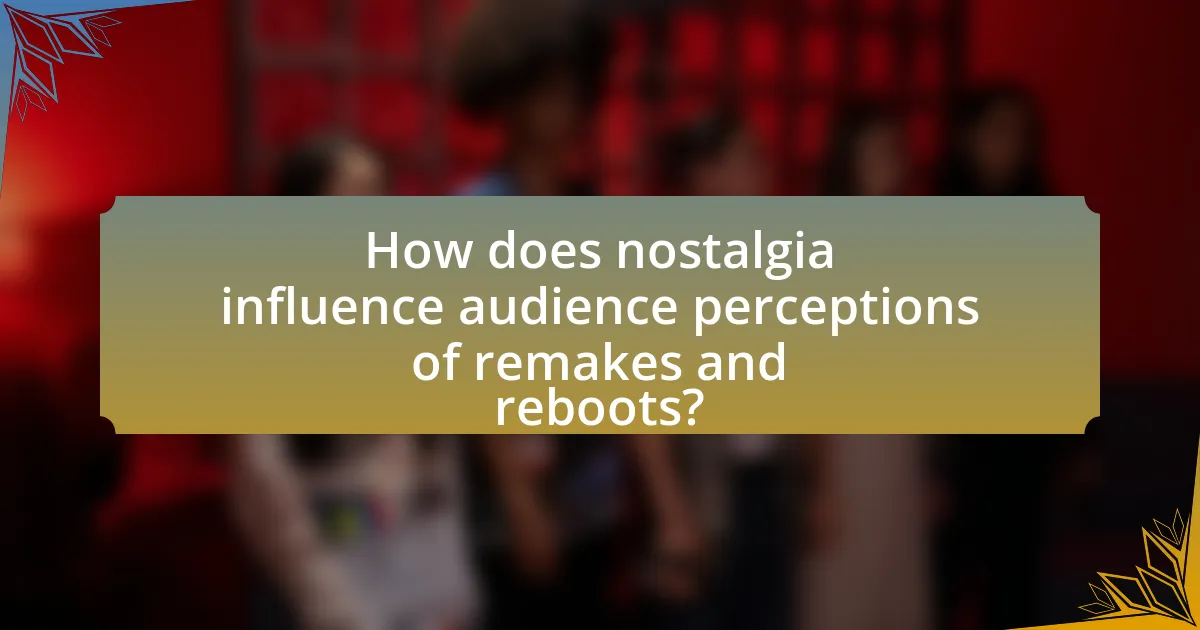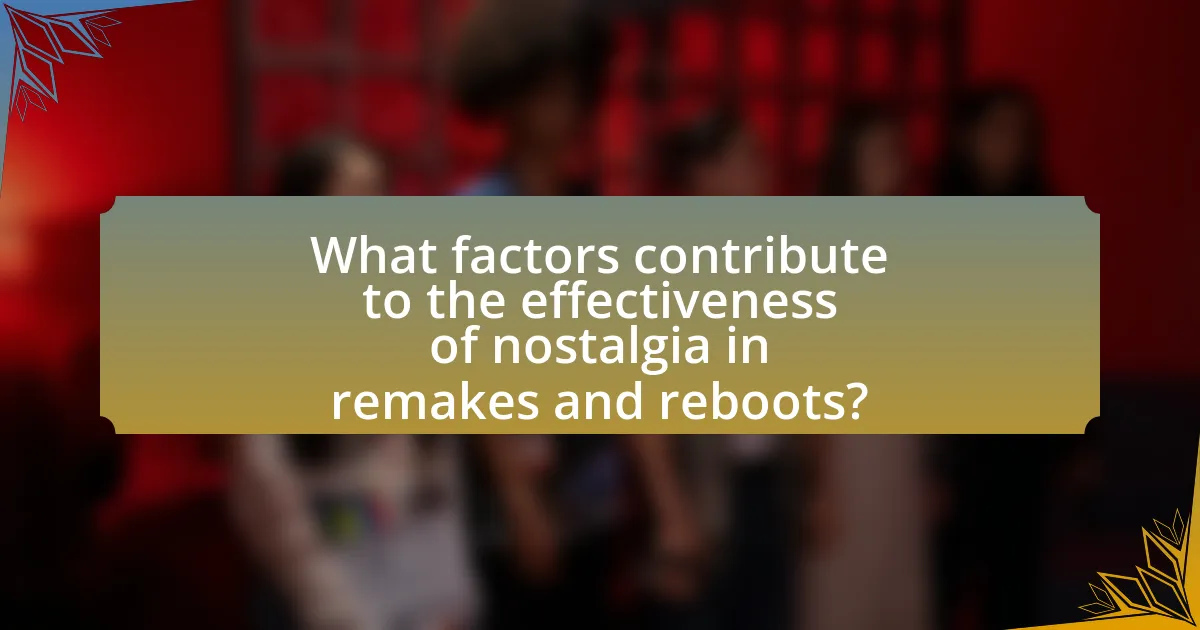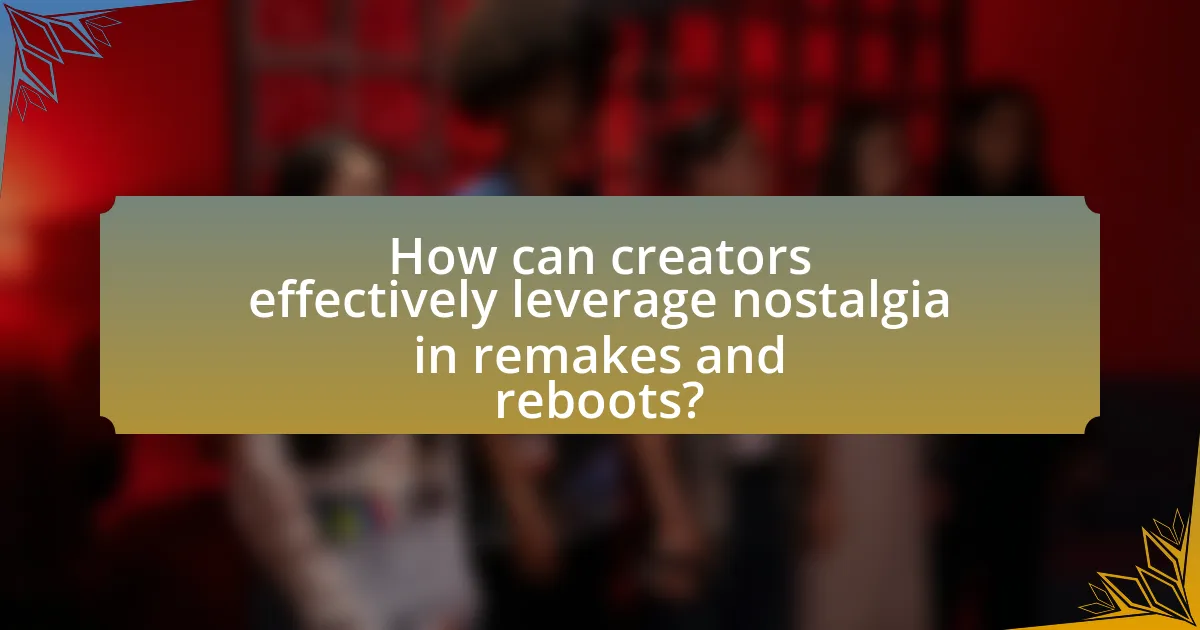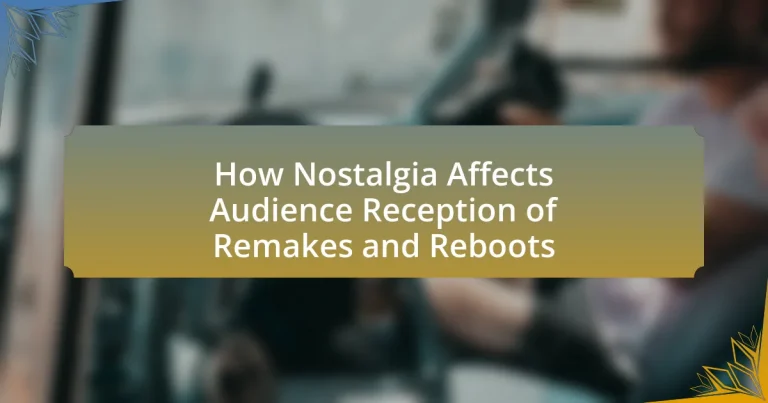Nostalgia plays a crucial role in shaping audience perceptions of remakes and reboots, fostering emotional connections and enhancing enjoyment through familiarity with original content. The article explores the psychological mechanisms behind nostalgia, including memory recall and emotional regulation, and how these factors influence audience engagement with familiar narratives. It examines the motivations for seeking nostalgic content, the impact of cultural contexts and generational perspectives, and the effectiveness of nostalgic elements in storytelling. Additionally, the article discusses best practices for creators to balance nostalgia with innovation while avoiding pitfalls associated with over-reliance on nostalgic sentiments.

How does nostalgia influence audience perceptions of remakes and reboots?
Nostalgia significantly influences audience perceptions of remakes and reboots by creating a sense of familiarity and emotional connection to the original content. This emotional resonance often leads audiences to view remakes more favorably, as they evoke cherished memories and experiences associated with the original work. Research indicates that nostalgic feelings can enhance enjoyment and appreciation, as seen in a study published in the Journal of Consumer Research, which found that nostalgia can increase positive evaluations of products, including films. Consequently, audiences may overlook flaws in remakes or reboots, focusing instead on the nostalgic elements that resonate with their past experiences.
What psychological mechanisms are at play in nostalgia?
Nostalgia is primarily driven by psychological mechanisms such as memory recall, emotional regulation, and social connectedness. Memory recall allows individuals to access past experiences, often idealized, which can evoke strong emotional responses. Emotional regulation is facilitated through nostalgia, as it can provide comfort and a sense of belonging, particularly during times of stress or uncertainty. Social connectedness is enhanced by nostalgia, as it often involves shared memories with others, reinforcing social bonds and collective identity. Research indicates that nostalgic feelings can lead to increased feelings of warmth and positivity, which can influence audience reception of remakes and reboots by creating a favorable context for engagement with familiar narratives.
How does nostalgia evoke emotional responses in audiences?
Nostalgia evokes emotional responses in audiences by triggering memories of past experiences that are often associated with positive feelings. This emotional connection is rooted in the brain’s reward system, where recalling nostalgic memories releases dopamine, enhancing feelings of happiness and comfort. Research indicates that nostalgia can increase social connectedness and improve mood, as evidenced by studies showing that nostalgic recollections can lead to greater feelings of belonging and self-esteem. For instance, a study published in the journal “Emotion” by Wildschut et al. (2006) found that participants who engaged in nostalgic reflection reported higher levels of positive affect and a stronger sense of social support. Thus, nostalgia serves as a powerful emotional tool that influences audience reception by fostering a sense of warmth and familiarity, particularly in the context of remakes and reboots.
What role does memory play in shaping nostalgia?
Memory plays a crucial role in shaping nostalgia by serving as the repository of past experiences that individuals recall and emotionally connect with. This connection influences how people perceive and respond to cultural artifacts, such as remakes and reboots, by evoking feelings tied to their personal histories. Research indicates that nostalgia is often triggered by specific memories, which can enhance emotional engagement with familiar narratives or characters, making audiences more receptive to adaptations that resonate with their past experiences. For instance, studies have shown that nostalgic memories can increase positive feelings towards media, leading to a greater likelihood of enjoying and accepting remakes that reflect those cherished memories.
Why do audiences seek out nostalgic content in remakes and reboots?
Audiences seek out nostalgic content in remakes and reboots primarily because it evokes positive memories and emotions associated with their past experiences. This emotional connection enhances their engagement with the material, as nostalgia can trigger feelings of comfort and familiarity. Research indicates that nostalgia can increase feelings of social connectedness and improve mood, making audiences more receptive to familiar narratives and characters. For instance, a study published in the journal “Psychological Science” by Wildschut et al. (2006) found that nostalgia can foster a sense of belonging and continuity, which audiences often crave in an increasingly fragmented world. Thus, the appeal of nostalgia in remakes and reboots lies in its ability to resonate emotionally with viewers, reinforcing their desire for content that reflects their cherished memories.
What are the motivations behind audience preferences for familiar stories?
Audience preferences for familiar stories are primarily motivated by nostalgia, comfort, and cognitive ease. Nostalgia evokes positive emotions associated with past experiences, making familiar narratives appealing as they trigger fond memories. Comfort arises from the predictability of familiar plots and characters, allowing audiences to engage without the anxiety of the unknown. Cognitive ease is facilitated by the recognition of established story structures, which reduces mental effort in processing the narrative. Research indicates that nostalgia can enhance enjoyment and emotional connection, as seen in studies like “Nostalgia: A Psychological Resource” by Routledge et al., which highlights how nostalgic feelings can lead to increased preference for familiar media.
How does nostalgia affect the anticipation of remakes and reboots?
Nostalgia significantly enhances the anticipation of remakes and reboots by creating a sense of emotional connection and familiarity among audiences. This emotional connection stems from positive memories associated with the original content, which can lead to heightened expectations for the new version. Research indicates that nostalgia can evoke feelings of warmth and belonging, making audiences more receptive to revisiting familiar stories. For instance, a study published in the Journal of Consumer Research found that nostalgic feelings can increase consumers’ willingness to engage with products that remind them of their past, including films and television shows. This emotional engagement often translates into increased excitement and anticipation for remakes and reboots, as audiences hope to relive cherished experiences while also exploring new interpretations of beloved narratives.

What factors contribute to the effectiveness of nostalgia in remakes and reboots?
The effectiveness of nostalgia in remakes and reboots is primarily influenced by emotional connection, familiarity, and cultural significance. Emotional connection arises when audiences recall positive memories associated with the original content, enhancing their engagement with the remake or reboot. Familiarity plays a crucial role, as recognizable characters, themes, and storylines can evoke a sense of comfort and anticipation, making the new version more appealing. Cultural significance is also vital; remakes and reboots that resonate with shared societal experiences or historical contexts can deepen the nostalgic impact, reinforcing audience attachment. For instance, studies have shown that nostalgia can enhance viewer satisfaction and emotional responses, leading to higher box office performance and critical acclaim for remakes that successfully tap into these factors.
How do cultural contexts shape nostalgic experiences in media?
Cultural contexts significantly shape nostalgic experiences in media by influencing the themes, symbols, and emotional responses that audiences associate with specific content. For instance, media that reflects the cultural values and historical events of a particular society can evoke nostalgia by resonating with shared memories and collective identity. Research indicates that nostalgia is often tied to personal and cultural history, as seen in studies like “Nostalgia: A Psychological Resource” by Wildschut et al., which highlights how cultural narratives can enhance feelings of nostalgia. This connection is evident in remakes and reboots that draw on familiar cultural references, allowing audiences to relive past experiences and emotions, thereby enhancing their reception of the media.
What impact does generational perspective have on nostalgia?
Generational perspective significantly influences nostalgia by shaping the emotional connections individuals have with cultural artifacts from their past. Different generations experience nostalgia through the lens of their unique historical contexts, leading to varying degrees of attachment to specific media, music, and events. For instance, Baby Boomers may feel nostalgic for the music of the 1960s, while Millennials might have a stronger connection to 1990s pop culture. This generational divergence affects how audiences perceive and receive remakes and reboots, as nostalgia can enhance the appeal of familiar content, making it more likely for individuals to engage with it. Research indicates that nostalgia can evoke positive emotions and a sense of belonging, which can be particularly potent when a remake or reboot resonates with the formative experiences of a specific generation, thereby influencing its commercial success and critical reception.
How do societal trends influence the reception of nostalgic content?
Societal trends significantly influence the reception of nostalgic content by shaping audience expectations and emotional connections. For instance, during periods of economic uncertainty, audiences may gravitate towards nostalgic content that evokes simpler, more stable times, as seen in the resurgence of 1980s and 1990s media during the 2008 financial crisis. This trend is supported by research from the Journal of Consumer Research, which indicates that nostalgia can serve as a coping mechanism, enhancing feelings of social connectedness and comfort. Consequently, the alignment of nostalgic themes with current societal sentiments can enhance the appeal and acceptance of remakes and reboots, making them more resonant with contemporary audiences.
What elements of remakes and reboots resonate most with nostalgic audiences?
Nostalgic audiences resonate most with familiar characters, iconic storylines, and recognizable aesthetics in remakes and reboots. These elements evoke emotional connections tied to past experiences, enhancing viewer engagement. For instance, studies show that remakes featuring beloved characters often achieve higher box office success, as seen with films like “Jurassic World,” which capitalized on the nostalgia for the original “Jurassic Park.” Additionally, the use of original soundtracks or visual styles can trigger memories, further solidifying the emotional impact. This connection to the past is crucial, as nostalgia can significantly influence audience reception and overall enjoyment of remakes and reboots.
How do visual and auditory cues trigger nostalgia in film and television?
Visual and auditory cues trigger nostalgia in film and television by evoking memories and emotions associated with past experiences. These cues, such as specific color palettes, familiar music, or iconic sound effects, create a sensory connection that can transport viewers back to earlier times in their lives. Research indicates that the brain’s reward system is activated when individuals encounter these stimuli, reinforcing positive feelings linked to nostalgia. For example, a study published in the journal “Psychological Science” by Wildschut et al. (2006) found that nostalgic memories can enhance mood and increase social connectedness, demonstrating how these cues effectively elicit nostalgic responses.
What storytelling techniques enhance nostalgic appeal in remakes?
Storytelling techniques that enhance nostalgic appeal in remakes include the use of familiar character arcs, iconic dialogue, and visual aesthetics that evoke the original work. Familiar character arcs allow audiences to reconnect with beloved figures, while iconic dialogue can trigger memories associated with the original narrative. Visual aesthetics, such as color palettes and cinematography reminiscent of the original, further immerse viewers in a nostalgic experience. Research indicates that these techniques effectively trigger emotional responses linked to past experiences, reinforcing the connection between the audience and the remake.

How can creators effectively leverage nostalgia in remakes and reboots?
Creators can effectively leverage nostalgia in remakes and reboots by incorporating familiar elements from the original work, such as iconic characters, memorable quotes, and signature themes. This strategy taps into the audience’s emotional connections and memories associated with the original, enhancing their engagement and enjoyment. For instance, the 2017 reboot of “It” successfully utilized the original 1990 miniseries’ themes and character dynamics, resulting in a box office success of over $700 million worldwide. By blending these nostalgic elements with modern storytelling techniques, creators can attract both original fans and new viewers, thereby maximizing audience reception and commercial viability.
What best practices should creators follow when incorporating nostalgia?
Creators should ensure that nostalgia is authentically integrated into their work by focusing on elements that resonate with the target audience’s past experiences. This involves using recognizable symbols, themes, or references that evoke positive memories, such as iconic music, visuals, or storylines from the original content. Research indicates that nostalgia can enhance emotional engagement; for instance, a study published in the Journal of Consumer Research found that nostalgic content can increase feelings of warmth and connection, leading to a more favorable reception of remakes and reboots. Additionally, creators should balance nostalgia with fresh perspectives to avoid alienating new audiences while still appealing to long-time fans.
How can creators balance nostalgia with innovation in storytelling?
Creators can balance nostalgia with innovation in storytelling by integrating familiar elements that evoke emotional connections while introducing fresh narratives or perspectives. For instance, successful remakes often retain iconic characters or settings, as seen in the 2017 adaptation of “It,” which preserved the original’s essence while updating themes for contemporary audiences. This approach leverages nostalgia to attract viewers while innovating through modern storytelling techniques, such as diverse character representation and updated social contexts. Research indicates that audiences respond positively when they recognize beloved aspects, as it enhances their engagement, while new elements keep the content relevant and appealing.
What pitfalls should creators avoid when appealing to nostalgic sentiments?
Creators should avoid over-reliance on nostalgia, as it can alienate new audiences and diminish the originality of their work. When creators excessively lean on familiar elements from the past, they risk creating a product that feels derivative rather than innovative, which can lead to negative reception. For instance, a study by the University of Southern California found that while nostalgia can enhance emotional engagement, it can also create unrealistic expectations if the new content fails to meet the standards set by the original. Additionally, creators should be cautious of misrepresenting the original material, as this can frustrate long-time fans and lead to backlash.
What are the potential consequences of over-reliance on nostalgia?
Over-reliance on nostalgia can lead to a stagnation of creativity and innovation in media. When creators prioritize nostalgic elements over original storytelling, they risk alienating new audiences and limiting the potential for fresh ideas. This phenomenon is evident in the film industry, where numerous remakes and reboots often rely heavily on familiar themes and characters, resulting in diminished critical reception and audience engagement. For instance, a study by the University of Southern California found that films heavily marketed on nostalgia tend to perform poorly in terms of originality, leading to a decline in overall viewer satisfaction.
How can excessive nostalgia impact audience engagement and satisfaction?
Excessive nostalgia can negatively impact audience engagement and satisfaction by creating unrealistic expectations and diminishing the perceived value of new content. When audiences are overly focused on nostalgic elements, they may become critical of modern interpretations or adaptations, leading to disappointment. Research indicates that nostalgia can evoke strong emotional responses, but when it overshadows the quality of the current experience, it can result in disengagement. For instance, a study published in the Journal of Consumer Research found that while nostalgia can enhance emotional connection, excessive reliance on it can lead to dissatisfaction if the new content fails to meet the idealized memories associated with the past.
What lessons can be learned from successful and unsuccessful nostalgic remakes?
Successful nostalgic remakes often emphasize authenticity and emotional resonance, while unsuccessful ones frequently fail to capture the original’s essence. Successful remakes, such as “It” (2017), effectively blend modern storytelling with nostalgic elements, appealing to both new audiences and fans of the original. In contrast, remakes like “Ghostbusters” (2016) struggled due to a perceived lack of respect for the source material, leading to negative reception. The lesson is that maintaining the core themes and emotional connections of the original while innovating for contemporary audiences is crucial for success.
What strategies can audiences use to critically engage with nostalgic remakes and reboots?
Audiences can critically engage with nostalgic remakes and reboots by analyzing the differences between the original and the new versions. This involves assessing how the remake interprets themes, character development, and cultural context compared to the original. For instance, examining how a reboot updates social issues or reflects contemporary values can reveal its relevance or lack thereof. Additionally, audiences should consider the motivations behind the remake, such as commercial interests versus artistic expression, which can influence the quality and authenticity of the adaptation. Engaging in discussions with others about these aspects can further enhance critical perspectives, as collective insights often uncover deeper meanings and critiques.


